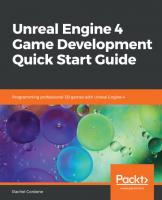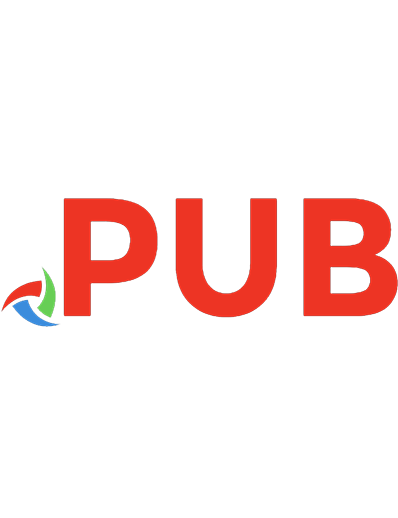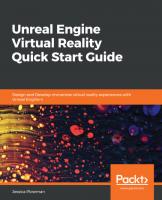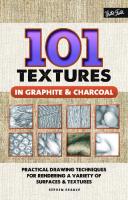Creating Games with Unreal Engine, Substance Painter, & Maya: Models, Textures, Animation, & Blueprint 0367512637, 9780367512637
Description: This tutorial-based book allows readers to create a first-person game from start to finish using industry-s
2,239 671 150MB
English Pages 826 [827] Year 2020

- Author / Uploaded
- Kassandra Arevalo
- Matthew Tovar
- Jingtian Li
- Categories
- Computers
- Programming: Games
Table of contents :
Cover
Half Title
Title Page
Copyright Page
Dedication
Table of Contents
Acknowledgments
Authors
Introduction
Chapter 1: Maya Modeling
Basics of Navigation
Rendering
What is a 3D Model?
Translation
Anatomy of a Model
Edge
Vertex
Face
Object Mode
Normal
Modeling Rules
Polycount
Topology
Size and Proportion
Basics of Modeling
Tutorial 1.1: Modeling a Security Camera
Other Useful Commands
Grow and Shrink Selection
Extract Faces
Combine and Separate
Create Cables or Pipes
Extrude Along a Curve
Duplicate, Duplicate with Transform
Duplicate Special
Mirror
Center Pivot
Change Pivot
Snapping
Hide Model
View Control
Assignments
Geometry Errors
Tutorial 1.2: Modular Set Pieces
Grid
Create a Base Floor
Conclusion
Chapter 2: Maya Set UV
The UV Editor
UV Points
UV Tiles
Cut UV
The Problem
UV the Floor
Texel Density
Chose the Right Texel Density
UV the Pod
Conclusion
Chapter 3: Set Texturing
PBR
Baking
Tutorial 3.1: Texturing Modular Pieces
The Substance Painter UI
Navigation
Light Direction
Ambient Occlusion
PBR Material Channels
Generators
Levels
Assignment: Texturing the Rest of the Models
Conclusion
Chapter 4: Level Asset Creation
Game Engines
Unreal Engine
Tutorial 4.1: Get Unreal Engine 4 and Visual Studio Up and Running
Visual Studio
UI of the Unreal Editor
Navigation
Tutorial 4.2: Export Our Assets to Unreal and Build Our Material
The Material Editor
Color R, G, B, A Channels
Material Instance
Tutorial 4.3: Set up a Test Hallway
Tutorial 4.4: Create Parameters for Our Materials
Actors
Mobility
Conclusion
Chapter 5: Level Creation
Tutorial 5.1: Create the Interior of Our Level
Assignment
Tutorial 5.2: Create the Landscape of Our Level
The Quixel Megascan Ecosystem
Tutorial 5.3: Set Up Quixel Bridge
Tutorial 5.4: Create the Landscape Material
Material Function
Tutorial 5.5: Place 3D Assets on the Landscape
Conclusion
Chapter 6: Lighting and Baking
Baking
Lightmaps
Lightmap UV
Lightmap Resolution
Lightmap Density
Volumetric Lightmaps
Mobility
Tutorial 6.1: Optimize the Lightmap Resolution
Lightmass Importance Volumes
Lower Down Baking Quality for Quick Iteration
Tutorial 6.2: Adjust Lighting
Tutorial 6.3: Add Post Processing and Other Effects
Post Process Volume
Assignment
Conclusion
Chapter 7: Character Modeling
Concept Art
Style Sheets
Workflow
Polycount
Setting Up Image Plane in Maya
Eyeball
Create the Eyelids
Create the Eye Socket
Forehead and Nose
Mouth
Rest of the Head
Ear
Neck
Internal Structures
Body
Hands
Hairs
Weapon
Final Clean Up
Conclusion
Chapter 8: UV Mapping
UV Mapping
Tutorial 8.1: Character UV Mapping
Mesh Inspection and Cleanup
Body UV
Eye UV
Hair UV
Garment UV
Conclusion
Chapter 9: Character Texture Painting
Skin Texturing
Hair
Eye
Upper Body
Pants
Belts, Straps, Pockets, Holster, and Boots
Gloves
Watch
Gun
Other Details
Export Textures
Conclusion
Chapter 10: Rigging
Joint Behavior
Joint Placement—Hip, Spine, Neck, and Head
Tutorial 10.1: Create the Joint Chain for Our Character
World Joint
Joint Placement—Left Arm
Joint Setup—Right Arm
Joint Setup—Legs
Foot Roll Rig
Setting Up the Foot Hierarchy
Tutorial 10.2: Bind and Paint Skin Weighting
Painting Skin Weights
Mirroring the Skin Weights
Copying the Skin Weights
Tutorial 10.3: Set Up Arm Controls
Constrains
IK Arm Setup
Tutorial 10.4: Finger Controls
Tutorial 10.5: Clavicle and Body Controls
Gun Joint
Final Hierarchy
Conclusion
Chapter 11: FPS Animation in Maya
FPS Animation Overview
Referencing the Character Rig
Save Files
Display Layers
Camera Configuration
Game Animations
Creating a Pose
Weapon Movement Simplified
Two-Handed Weapon Setup
Frame Rate
Idle Animation
Cleaning Up Odd Jitters
Ease-In’s and Ease-Out’s
Graph Editor
Keywords Aside
Attack Animation
Walk Animation
“Got Caught” Animation
Keywords Aside
Reload Animation
Considerations and Conclusion
Chapter 12: Unreal Character Asset Creation
Tutorial 12.1: Character Asset Import
Skeletal Mesh, Skeleton, and Physics Asset
Subsurface Scattering
Tutorial 12.2: Export FPS Animations
Bake Animation
Tutorial 12.3: Motion Captured Data
Tutorial 12.4: Animation Retargeting
Conclusion
Chapter 13: Basics of Programming
Relevant Programming Languages (From Hard to Easy)
C++
C#
Python
Blueprint
Tutorial 13.1: Create an UI
Event Graph
Execution Pin and the Order of Execution
GameMode
Functions
Machine Code, Source Code, and Compiling
Tutorial 13.2: Refactoring Our Load Level Mechanic
Variable
Variable Types
Built-In Variable Types
Custom Variable Types
Class
Tutorial 13.3: Make a Sliding Door Class
Parent Class
Character
Collision
Casting
Conclusion
Chapter 14: Player Character
Tutorial 14.1: Create the First-Person Shooter Character
Pawn and Character
Roll, Yaw, Pitch
Controller
PlayerController
AIController
Tutorial 14.2: Set Up the Animation
Animation Blueprint
Event Graph
Animation Graph
Vector
State Machine
Game Mode
Player Controller/Controller/ AIController
Actor
Pawn
Character
Skeletal Mesh
Animation Blueprint
Widget Blueprints
Chapter 15: Weapons
Tutorial 15.1: Create a Base Weapon Class
Socket
Owner
Instigator
Persona
Animation Montage
Comment Box
Tutorial 15.2: Weapon Attack Cooldowns
Enumeration
Tutorial 15.3: Weapon Damage
Array
Loop
Conclusion
Chapter 16: Health and Damage
Tutorial 16.1: Create a Health Component
Actor Component
Tutorial 16.2: Character Hit and Death
Tutorial 16.3: Health Regeneration
Conclusion
Chapter 17: Inventory and UI
Tutorial 17.1: Weapon Pickup
Tutorial 17.2: Weapon Switching
Tutorial 17.3: Create the In-Game Weapon UI
Widget Switcher
Canvas Panel
Anchors
Alignment
Tutorial 17.4: Create the Health Bar
Tutorial 17.5: Create the Pause and Game Over UI
Assignment
Conclusion
Chapter 18: Security Camera
Tutorial 18.1: Implement an AISeer in C++
The Header and the Source File
Tutorial 18.2: Create the Blueprint Version of AISeer by Inheriting from the C++ Version
Tutorial 18.3: Create a Security Camera
Tutorial 18.4: Create a BP_Monitor Class that Shows What the Camera Sees
Structure
Conclusion
Chapter 19: Patrolling AI
Tutorial 1: Create the Patrol AI Character
Tutorial 2: Create AI Controller and Behavior Tree for the Patrol AI
Blackboard and Behavior Tree
Cache Pose
Conclusion
Chapter 20: Boss
Tutorial 20.1: Create the Boss Class
Tutorial 20.2: Boss Attack
Tutorial 20.3: Boss Death and Winning
Conclusion
Chapter 21: Audio and VFX
Tutorial 21.1: Add Audio to the Game
Tutorial 21.2: Add Extra VFX to the Game
Conclusion
Chapter 22: Packaging
Tutorial 22.1: Package the Game for Windows
Conclusion
Index


![Immersive 3D Design Visualization: With Autodesk Maya and Unreal Engine 4 [1st ed.]
9781484265963, 9781484265970](https://dokumen.pub/img/200x200/immersive-3d-design-visualization-with-autodesk-maya-and-unreal-engine-4-1st-ed-9781484265963-9781484265970.jpg)

![Multiplayer Game Development with Unreal Engine 5: Create compelling multiplayer games with C++, Blueprints [Team-IRA]
1803232870, 9781803232874](https://dokumen.pub/img/200x200/multiplayer-game-development-with-unreal-engine-5-create-compelling-multiplayer-games-with-c-blueprints-team-ira-1803232870-9781803232874.jpg)




